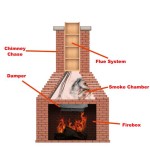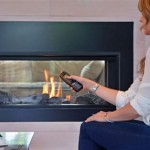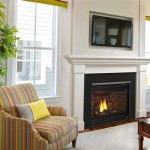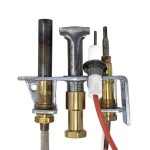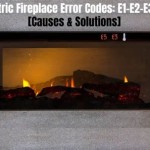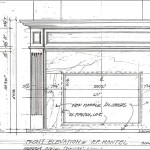Understanding Gas Fireplace Wall Mount Venting
Gas fireplaces offer a convenient and aesthetically pleasing heating solution for residential and commercial spaces. Unlike traditional wood-burning fireplaces, gas fireplaces eliminate the need for wood storage and produce less ash. A critical component of any gas fireplace installation is the venting system, which safely expels combustion byproducts, such as carbon dioxide and water vapor, outside the building. Wall-mounted venting options provide flexibility in fireplace placement and can be particularly advantageous in situations where conventional chimney installations are impractical or impossible. This article will explore the intricacies of gas fireplace wall mount venting, examining the different types of systems, installation considerations, and safety aspects.
The primary function of a gas fireplace vent is to create a safe and efficient pathway for exhaust gases to escape the building. Without proper venting, these gases can accumulate indoors, posing serious health risks, including carbon monoxide poisoning. The venting system also helps maintain optimal fireplace performance by ensuring a constant supply of fresh air for combustion. The selection of an appropriate venting system is dictated by the type of gas fireplace, local building codes, and the specific architectural characteristics of the building.
Types of Gas Fireplace Wall Mount Venting Systems
Several types of venting systems are available for wall-mounted gas fireplaces, each with its own set of characteristics and applications. Direct vent (DV) systems, vent-free (VF) systems, and B-vent systems represent the most common options. Understanding the differences between these systems is crucial for selecting the optimal solution for a given installation.
Direct Vent (DV) Systems: Direct vent systems are considered the safest and most efficient option for gas fireplaces. DV systems utilize a sealed combustion chamber that draws air from outside the building for combustion and expels exhaust gases directly outdoors through a coaxial or concentric vent pipe. This pipe consists of two channels: an inner pipe for exhaust and an outer pipe for intake air. The sealed combustion chamber eliminates the risk of indoor air contamination and ensures optimal combustion efficiency. DV systems can be vented horizontally through an exterior wall or vertically through the roof. The horizontal venting capability makes them particularly well-suited for wall-mounted installations where a traditional chimney is not feasible. The vent pipe typically terminates with a decorative cap to prevent backdrafts and protect the system from weather elements. Because they pull air from outside, they do not rely on or deplete inside air.
Vent-Free (VF) Systems: Vent-free gas fireplaces, also known as ventless or unvented fireplaces, do not require a dedicated venting system. These systems are designed to burn gas with a high level of efficiency, minimizing the production of harmful emissions. While VF fireplaces are equipped with oxygen depletion sensors (ODS) that shut off the gas supply if oxygen levels in the room drop to unsafe levels, they are not recommended for enclosed spaces or homes with poor ventilation. The combustion process inherently releases water vapor and some carbon dioxide into the room, which can potentially lead to moisture buildup and air quality concerns over time. Furthermore, some jurisdictions have restrictions or outright bans on vent-free appliances due to safety considerations. For wall-mounted installations, VF systems offer ease of installation due to the absence of venting requirements, but their use should be carefully evaluated based on local regulations, room size, and ventilation capabilities.
B-Vent Systems: B-vent systems, also known as natural vent systems, rely on natural convection to exhaust combustion gases through a single-wall metal vent pipe. B-vent systems require a continuous vertical run to the outside, typically terminating above the roofline. They draw combustion air from the room, which can potentially lead to drafts and reduced heating efficiency. While B-vent systems are less expensive than direct vent systems, they are less efficient and pose a higher risk of backdrafting and indoor air contamination. B-vent systems are generally not suitable for wall-mounted gas fireplaces because they require a vertical chimney run, rendering horizontal wall venting impossible. Furthermore, B-vent systems are becoming less common due to stricter energy efficiency and safety standards.
Installation Considerations for Wall Mount Venting
Proper installation is paramount for the safe and efficient operation of a gas fireplace with wall mount venting. Adherence to manufacturer's instructions, local building codes, and industry best practices is essential. A qualified and licensed gas appliance installer should perform the installation to ensure compliance and minimize the risk of potential hazards.
Vent Pipe Selection and Placement: The choice of vent pipe material and diameter is crucial for optimal performance and safety. Direct vent systems typically utilize double-walled vent pipes made of stainless steel or aluminum, designed to withstand high temperatures and prevent corrosion. The vent pipe diameter must match the fireplace manufacturer's specifications to ensure proper airflow and prevent backpressure. The vent pipe must be installed with the correct slope to facilitate condensate drainage and prevent moisture buildup. The termination point of the vent pipe must be located in accordance with local codes to ensure adequate clearance from windows, doors, and other building openings. Furthermore, the vent termination should be shielded from prevailing winds to prevent backdrafting.
Clearances and Fire Safety: Maintaining proper clearances between the fireplace and surrounding combustible materials is crucial for preventing fire hazards. The fireplace manufacturer's instructions will specify the minimum clearances required for walls, floors, ceilings, and furniture. Non-combustible materials, such as brick or stone, can be used to reduce clearance requirements in some cases. A fire-resistant barrier, such as cement board, may be required behind the fireplace to protect the wall from excessive heat. Smoke detectors and carbon monoxide detectors should be installed in the vicinity of the fireplace to provide early warning in case of a fire or carbon monoxide leak. Regular inspection and maintenance of the fireplace and venting system are essential for ensuring continued safe operation.
Gas Line Connection: The gas line connection to the fireplace must be performed by a qualified gas fitter in accordance with local codes and regulations. The gas line must be properly sized to provide adequate gas supply to the fireplace. A shut-off valve should be installed in the gas line near the fireplace to allow for easy disconnection in case of emergencies or maintenance. The gas line connection must be tested for leaks using a gas leak detector or soap solution. Any leaks must be repaired immediately to prevent potential gas explosions or carbon monoxide poisoning.
Safety Aspects of Gas Fireplace Wall Mount Venting
Safety is the paramount concern when dealing with gas fireplaces and their venting systems. Proper installation, regular maintenance, and adherence to safety guidelines are essential for preventing accidents and ensuring the well-being of occupants.
Carbon Monoxide Detection: Carbon monoxide (CO) is a colorless, odorless, and highly toxic gas produced by incomplete combustion. Gas fireplaces, if not properly vented or maintained, can potentially release carbon monoxide into the home. Carbon monoxide detectors should be installed on every level of the home, particularly near sleeping areas. Regularly test the carbon monoxide detectors to ensure they are functioning properly. Replace the batteries in the detectors at least once a year. If the carbon monoxide detector alarm sounds, evacuate the building immediately and call emergency services.
Vent Inspection and Maintenance: The venting system should be inspected regularly for signs of damage, corrosion, or blockage. Animals, birds, or debris can sometimes obstruct the vent pipe, leading to reduced airflow and potential carbon monoxide buildup. Clean the vent pipe annually to remove any accumulated soot or debris. Check the vent pipe connections for leaks and ensure that all joints are properly sealed. Replace any damaged or corroded vent pipe sections immediately. A professional chimney sweep can provide a thorough inspection and cleaning of the venting system.
Pilot Light Safety: The pilot light is a small flame that ignites the main burner in a gas fireplace. If the pilot light goes out, it can potentially lead to a buildup of unburned gas, which could ignite explosively. Follow the manufacturer's instructions for relighting the pilot light. If you are unable to relight the pilot light, or if you smell gas, turn off the gas supply to the fireplace and call a qualified gas appliance technician. Never attempt to repair or modify the gas fireplace yourself without the proper training and expertise.
In summary, gas fireplace wall mount venting offers a practical and efficient solution for heating homes and businesses. Selecting the appropriate venting system, ensuring proper installation, and prioritizing safety are crucial for maximizing the benefits of gas fireplaces while minimizing potential risks. Adhering to manufacturer's instructions, local building codes, and industry best practices will contribute to the safe and reliable operation of gas fireplaces for years to come.

SÓlas Twenty6 Wall Mount Direct Vent Gas Fireplace Toronto Home Comfort

One6 Vf SÓlas Contemporary Fireplaces

SÓlas Twenty6 Wall Mount Direct Vent Gas Fireplace Toronto Home Comfort

Fire Ribbon Direct Vent Slim Gas Fireplace Spark Modern Fires

Napoleon Plazmafire 48 Linear Direct Vent Gas Fireplace Model Whd48

Fire Ribbon Direct Vent Slim Gas Fireplace Spark Modern Fires

SÓlas Twenty6 Wall Mount Direct Vent Gas Fireplace Toronto Home Comfort

What Is A Vent Free Fireplace

Napoleon Gas Direct Vent Wall Mount Fireplace Whd48 Fireplaces Hvacdirect Com

Napoleon Plazmafireâ 31 Direct Vent Gas Wall Hanging Fireplace
Related Posts

